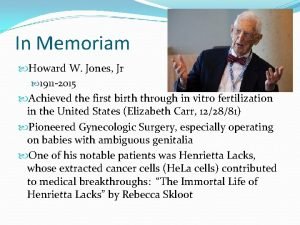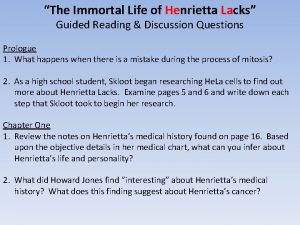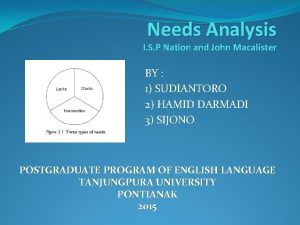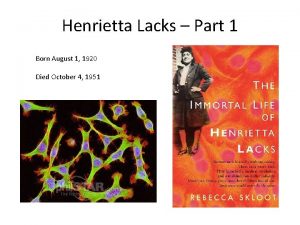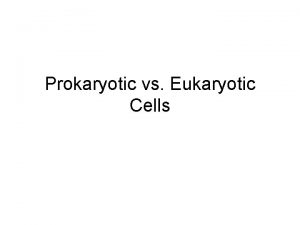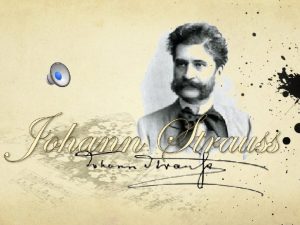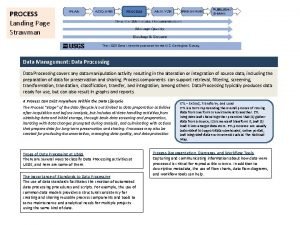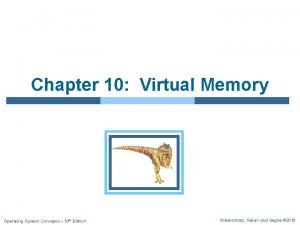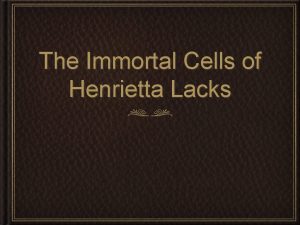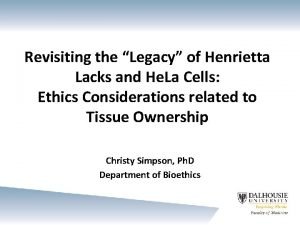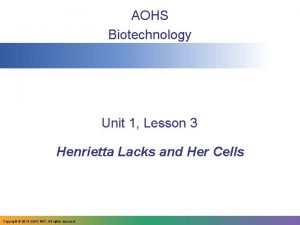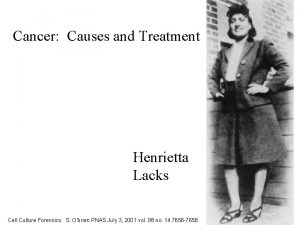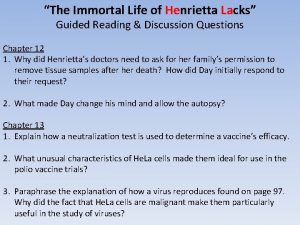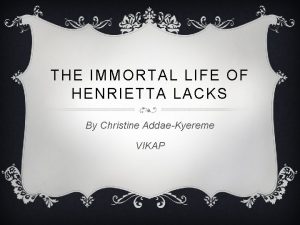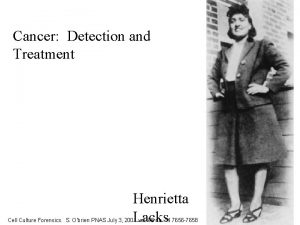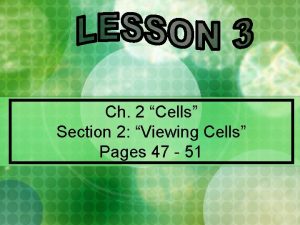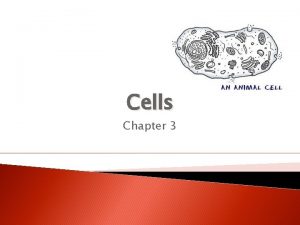Cells Henrietta Lacks Read pages 31 to 33










































- Slides: 42

Cells


Henrietta Lacks Read pages 31 to 33 Questions 1. What is Henrietta in the hospital for? 2. They ask Henrietta to sign something for permission to do anything. Is there anything wrong with this in your opinion? 3. What do you think they are going to with her cells.

Why are cells important? 1. You are made of cells!! 2. If you can understand your cells, you can understand your body. 3. All diseases/illness originates at a cellular level. 4. If you’re an athlete, your cells have to work together to make you run/jump. If you feed your cells right, and practice right, maybe you can become a better athlete. THIS HAPPENS IN YOUR CELLS!

Today, if you could pile all He. La cells ever grown onto a scale, they'd weigh more than 50 million metric tons — more than 100 Empire State Buildings. People have made millions and millions of dollars off of these cells. Henrietta and her family have never received any compensation.

Who helped in cell Theory Development? • Schleiden- all plants are made of cells • Schwann – all animals are made of cells • Virchow – new cells come only from existing cells

And then the Cell Theory 1. All living things are composed of cells 2. The cell is the basic unit of life 3. New cells come from preexisting cells

How are cells organized into organisms? Atoms molecules organelles cells tissues organ systems organisms

So…How big are cells? • Cells are small because they are able to function better at a smaller size • The larger the cell, the smaller the surface area to volume ratio. It takes longer to get food and gases to the inside of a large cell • The average cells range in size from 2 micrometers to 200 micrometers


What are two main groups of Cells? • Prokaryotic – has no nucleus or membrane organelles ( this does not include organelles that don’t have a membrane) • Eukaryotic- cell has a nucleus and membrane bound organelles

What are the key structural features? • Cell membrane ( plasma membrane) – surrounds all cells and controls what enters and leaves • Cell wall – For some cells this provides added support. Plants, fungi, bacteria • Cytoplasm ( cytosol) – jelly like fluid that everything floats around in. Moves by a process called cyclosis • http: //www. microscopy-uk. org. uk/mag/indexmag. html? http: //www. microscopyuk. org. uk/mag/artnov 00/dwelodea. html

What are the key organelles and how do they function • Nucleus – contains DNA, controls the cell • Mitochondria – Makes energy in the form of ATP • Endoplasmic Reticulum – transports proteins and fats • Ribosomes – Site of protein synthesis

What are the key structural features? • Lysosomes – digests food and old organelles • Chloroplast – converts light energy into food • Chromatin- the material eukaryote chromosomes are composed. It consists of protein, RNA, and DNA.

More organelles • Golgi apparatus – packages protein to leave the cell • Vacuoles – storage of water and food • Cilia /flagella – short hair-like structures that allow movement. Some eukaryotic and prokaryotic cells have flagella • Cytoskeleton – thread that run through the cytoplasm and give support and/or motion


Prokaryotic vs Eukaryotic

differences between prokaryotic and eukaryotic cells Prokaryotic cell • • DNA is free floating NO nucleus! Ribosomes are all free Cell wall ( peptidoglycan) Cell Membrane Cytoplasm Pili ( look like cilia) • • • Eukaryotic Cell DNA in nucleus Ribosomes may be free or bound to ER May have cell wall of cellulose (Plants) Cell Membrane Cytoplasm No pili


What’s the difference between a cell wall and a cell membrane?

Compare prokaryotic and eukaryotic cells using your notes.

What do prokaryotic and eukaryotic cells both have? Why do you think this is?

Differences between Plant and Animal Cells Plant • Cell wall of cellulose • Plasma membrane • Chloroplasts and other plastids • Large vacuole • No centrioles Animal • No cell wall • Plasma membrane • No plastids • Vacuoles are small when present • centrioles


Cell Specialization

• Unicellular – One Cell • A unicellular organism is a living that is just one cell. • There are different types of unicellular organism, including: – bacteria – protozoa – unicellular fungi

• Multicellular – many cells • A multicellular organism is a living that consists of more than one cell. • Examples: – Eukaryotes (plants & animals) – Multicellular fungi

Multicellular Organisms • Have three characteristics: 1. Can be seen with the naked eye. 2. Are specialized 3. Able to communicate

• All cells within an organism start out the same way as stem cells. • The DNA inside each cell is identical. • The DNA tells every cell what type of cell to become and makes special proteins to the job it is told to do.

Types of Specialized Cells Sperm Cells • Function: to reach female egg cells and fertilize it. • Special Structures: – Long flagella for swimming

Specialized Cells Continued Skin Cells • Function: Provides our bodies protection from outside pathogens, allows for sensation, and thermoregulation • Special Structures: – Never stop dividing – Forms many layers

Specialized Cells Continued Red Blood Cells • Function: to carry oxygen • Special Structures: – Large surface area for oxygen to pass through – Contains hemoglobin which joins with the oxygen – Does not contain a nucleus

Specialized Cells Continued White Blood Cells • Function: to protect the body against disease and foreign invaders. – There are different types of white bloods cells that are specialized for different immune responses. • Special Structures: – Lack hemoglobin but have a nucleus – Have granules that contain enzymes that damage or digest pathogens and release inflammatory mediators into the bloodstream

Specialized Cells Continued Muscle Cells (There are 3 types: cardiac, smooth, and skeletal) • Function: enables body parts to move, exert forces, or change shape • Special Structures: – Are long and thin in structure to allow for contracting and extending – Branching pattern increases strength – High concentration of mitochondria to supply energy required to change shape.

Specialized Cells Continued Nerve Cells • Function: to carry nerve impulses to different parts of the body. • Special Structures: – Long connections at each end – Can carry electrical signals

VIEWING CELLS - The light microscope • Basic compound light microscope • Magnifies about 400 x’s • Can be used for living or dead specimens • Light shines up through the base • Dissecting microscopes are like light microscopes but you get a 3 -D image • Used for whole specimens and large specimen • Magnificant is poor

The Electron Microscopes • Transition electron microscopes ( TEM) • Shoot a beam of electrons through the specimen to make a picture • Magnifies • Scanning electron microscopes ( SEM) • Shoot a beam of electrons across the surface giving a 3 -D picture • Magnifies Both SEM and TEM can only be used for dead specimens


TEM

SEM

Cell Variety and Specialization • In organisms cells are often specifically shaped and sized for their function • The may need to support, to transmit a signal or to pick up information from the surrounding • Cells can become specialized as different genes are turned on/off in different kinds of cells.

 The immortal life of henrietta lacks table of contents
The immortal life of henrietta lacks table of contents Howard jones henrietta lacks
Howard jones henrietta lacks The immortal life of henrietta lacks discussion questions
The immortal life of henrietta lacks discussion questions Printed pages vs web pages
Printed pages vs web pages Propaganda movement founder
Propaganda movement founder Rhea lacks temerity so she definitely would not
Rhea lacks temerity so she definitely would not Needs analysis necessities lacks wants
Needs analysis necessities lacks wants Work on the production line is monotonous and lacks
Work on the production line is monotonous and lacks Syphilus
Syphilus Flagella whip
Flagella whip Maria anna streim
Maria anna streim Finnegan scoring system
Finnegan scoring system Karolina fryderyka henrietta mercoeur
Karolina fryderyka henrietta mercoeur School tool rush henrietta
School tool rush henrietta Henrietta leavitt early life
Henrietta leavitt early life Henrietta toivanen
Henrietta toivanen Henrietta cooke
Henrietta cooke Biografia de henrietta leavitt
Biografia de henrietta leavitt Henrietta dombrovskaya
Henrietta dombrovskaya Prokaryotic vs eukaryotic cells
Prokaryotic vs eukaryotic cells Masses of cells form and steal nutrients from healthy cells
Masses of cells form and steal nutrients from healthy cells Chapter 8 cellular reproduction cells from cells
Chapter 8 cellular reproduction cells from cells Haploid and diploid venn diagram
Haploid and diploid venn diagram Venn diagram animal and plant cell
Venn diagram animal and plant cell Onodi cells and haller cells
Onodi cells and haller cells Label
Label Cells and life lesson 1 answer key
Cells and life lesson 1 answer key Why dna is more stable than rna
Why dna is more stable than rna Prokaryotic cell
Prokaryotic cell Tubular lumen
Tubular lumen What animals have prokaryotic cells
What animals have prokaryotic cells Red blood cells and white blood cells difference
Red blood cells and white blood cells difference Cell organelle jeopardy
Cell organelle jeopardy Pineal gland
Pineal gland Prokaryotic cells
Prokaryotic cells Strawman process
Strawman process Shared pages
Shared pages Whats double spaced
Whats double spaced Emergency response guidebook yellow section
Emergency response guidebook yellow section The following pages
The following pages A website is a collection of
A website is a collection of Section 16–3 the process of speciation (pages 404–410)
Section 16–3 the process of speciation (pages 404–410) A process is busy swapping pages in and out. *
A process is busy swapping pages in and out. *

